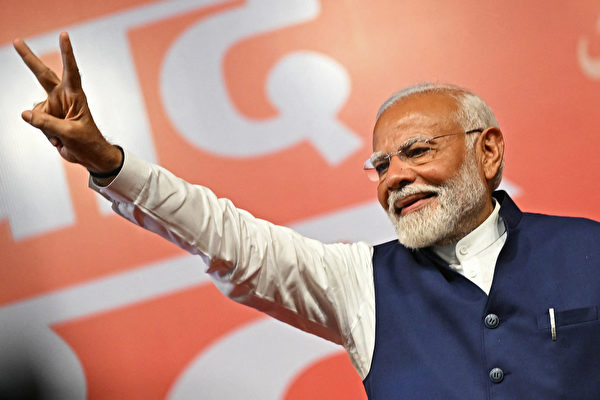Indian Prime Minister Narendra Modi has just won the election. Although he has not revealed how he will deal with the almost shattered India-China relationship within his third term, he repeatedly emphasized that he will continue to focus on enhancing the country’s military strength and deterrence. India is developing a stronger defense partnership with the United States than ever before.
According to the report by the Associated Press, following the election results, Modi told a group of supporters at his party headquarters, “The government will focus on expanding defense production and exports.” He also discussed plans to strengthen national security by reducing India’s reliance on weapons imports, stating, “We will not stop until self-sufficiency in the defense sector is achieved.”
India’s drive to strengthen its defense primarily stems from the threats on its northern borders. Since 2020, the Chinese Communist Party (CCP) has become India’s biggest security threat.
In 2020, 20 Indian soldiers lost their lives in clashes between Indian and Chinese troops on the northern border. Since then, the situation in the region has remained tense. The CCP has maintained close relations with India’s strategic rival Pakistan. It has also been enhancing military cooperation with India’s neighboring countries, including Nepal, Bangladesh, Maldives, and Sri Lanka, to expand its influence in the region.
This has led India, which used to follow a non-aligned foreign policy, to begin to counter the increasing influence of the CCP in the Indo-Pacific region. With this common goal in mind, the Indian government quickly moved closer to the United States.
Under Modi’s leadership, India has significantly expanded its defense cooperation with the United States, particularly through the Quadrilateral Security Dialogue (Quad), establishing security partnerships not only with the U.S. but also with Australia and Japan.
Last June, to strengthen defense relations with India, Washington approved an agreement allowing General Electric to collaborate with Hindustan Aeronautics Limited to produce fighter jet engines.
During the Shangri-La Dialogue held in Singapore last weekend, U.S. Secretary of Defense Lloyd Austin stated that the relationship between the U.S. and India is as good as ever, if not better. He mentioned, “It is a very strong relationship.”
When President Biden congratulated Modi on the election results, defense relations were also a major topic of their conversation. The White House said in a press release, “Both leaders emphasized in the call that they will deepen the comprehensive global strategic partnership between the U.S. and India, advancing a shared vision of a free, open, and prosperous Indo-Pacific region.”
New Delhi defense analyst Rahul Bedi, in an interview with the Associated Press, stated, “For the Americans, India is currently a frontline country. The Indian Navy plays a major role in the Indian Ocean region.”
Modi has secured a third term, but his Bharatiya Janata Party (BJP) lost its majority in parliament and will have to rely on coalition governance in the future, facing a stronger and more vibrant opposition.
However, Bedi believes that the main opposition party, the Indian National Congress, is unlikely to challenge Modi’s defense reforms, but they have been critical of Modi’s handling of the border issues with China. They believe Modi has not been transparent about the situation and has downplayed the severity of the situation. Modi may face pressure in this regard.
Under Modi’s military modernization and reform plans, India has been seeking to develop the private defense manufacturing industry, a sector previously restricted to government organizations. Additionally, Modi has relaxed foreign direct investment rules, encouraging multinational companies to establish research and development institutions in India, attracting investors, including those withdrawing investments from China.
India has also constructed its first indigenous aircraft carrier, the “Vikrant,” which officially entered service in September 2022. Last month, the Indian magazine “The Forum” reported that India will soon begin constructing its third aircraft carrier, marking the second indigenous aircraft carrier for India. This is part of India’s aircraft carrier battle group deployment plan to counter the CCP’s rising naval power.

